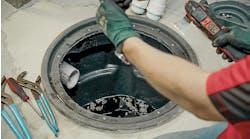LINE BREAKS AND roots have been a recurring problem when it comes to cleaning sewer lines. Over the years, we’ve used mechanical equipment designed to rip, tear and cut away roots. If dirt and gravel were brought back, we could safely assume the line was either separated or broken and we could get an approximate location by measuring the length of cables we had run into the line.
Finding additional cleanouts often presented a challenge if the lateral location wasn’t known or obvious. A metal detector often helped for locating below-grade cleanouts but was limited by its short depth range. The depth of the line could be determined once a cleanout was removed by extending a foot tape to the bottom. Not an exact science, but fairly close. If only we had X-ray vision!
Remember the 45,000-sq.-ft. timber-framed farmer’s market building where we’d inspected sewer lines with General Pipe Cleaner’s Gen-Eye 3 system? (March, pg. 34) or see http://www.contractormag.com/articles/column.cfm?columnid=286.
One of those lines was a 12-in. terracotta combination sanitary sewer and storm water drain. My architectural print from 1888 (the year the building was constructed) clearly shows this line being run straight along a sidewall, exiting the building and continuing in a straight line out into the street. The only point of access for this line is the towers where dual copper roof conductors drop down and disappear into the concrete.
From the original blueprint, the line was thought to run under a corner restaurant while passing by the neighboring basement where the leak was appearing next door. A 116-year-old 12-in. terracotta line with cement joints certainly raised suspicion as the source of infiltration! A brick lying in the line, which proved impossible to bypass, stymied our attempt to video the entire line. The crystal-clear color video image can be flipped on-screen to avoid standing on your head for proper orientation.
Before retrieving the camera, General’s Gen-Eye digital locator was used and the video monitor indicated we were some 55 ft. down the line - right in the middle of the corner restaurant’s dining area. In spite of our standing exactly where the print showed the line, we couldn’t seem to get a location signal.
Our General Pipe representative kept getting an indication the signal was coming from outside the restaurant where numerous vendor stands are located. Within a few minutes, he had pinpointed the exact location of the camera head and its depth below the concrete. The line was diverging from the centuries-old print and running toward the opposite corner on a 45-degree angle! If we had attempted to excavate by the blueprint, we would have met with failure and created a huge mess.
Next up was the Ridgid SeeSnake Plus system with its NaviTrack locator. To be fair, I made no mention of the brick or the line’s deviation from the blueprint. Ridgid’s color camera image was also quite clear and the image was self-leveling. If you’ve ever witnessed customers craning their necks to orient the horizontal while viewing older sewer-line tapes, you’ll appreciate how quickly a self-leveling image is taken for granted.
A set of stand-offs was attached to the camera to keep it out of any puddles and I knew there were several low spots we would encounter. Once again, the brick proved to be impassable. The NaviTrack locator was taken to the same spot inside the corner restaurant and the search began.
Ridgid’s locator comes with multiple sounds that remind you of a cross between a casino’s slot machines and a pinball machine. As their representative explained it to me, we were looking for the “poles” of the signal. If you think of the signal in 3-D terms, it would look like a Ferris wheel with the poles being the outer edges from an overhead view. NaviTrack comes with three colored discs to mark the poles and the sweet spot (center), which is centered directly over the camera.
A soon as the locator was turned on, a signal indicated a pole was off to the side and not where the blueprint suggested where it would be located. Within just a few minutes, the first pole was located and that spot corresponded with where the Gen-Eye had determined our line lay. I knew which way it was headed, but did NaviTrack?
Within a matter of seconds, both the sweet spot and the second pole had been found. The cheerful noises emanating from the locator quickly lead you in the right direction, as do the graphics.
While I was talking with the operations manager of York Central Market, Ridgid’s representative moved the camera head. He then handed me the locator to see if I could find the two poles and sweet spot. Piece of cake! In fact, the sweet spot turned out to be under a vendor’s stand, but I was able to shoot through the obstruction - both from above the counter and on an angle from floor level.
And, as with the Gen-Eye equipment, Ridgid’s NaviTrack gave me exact depth in addition to precise location. Both come with other features that give you the ability to trace “live” electrical lines or by inducing a signal into a wire or metallic piping.
So, now that we can see those tree roots and mark their precise point of intrusion, what do we do about dealing with them? I’ll be back next month to explore some interesting options.
Dave Yates owns F.W. Behler, a contracting company in York, Pa. He can be reached by phone at 717/843-4920 or by e-mail at [email protected].
All Dave Yates material on this website is protected by Copyright 2008. Any reuse of this material (print or electronic) must first have the expressed written permission of Dave Yates. Please contact via email at: [email protected]

